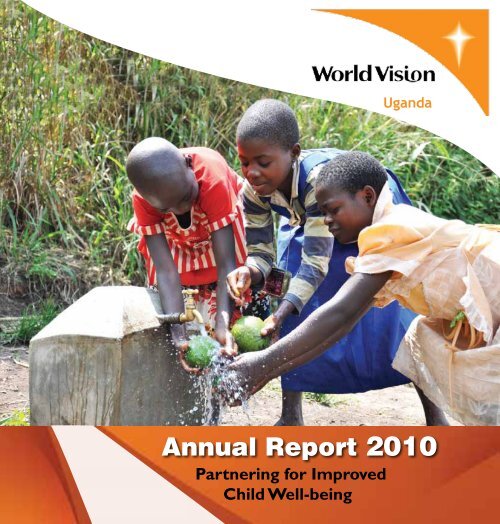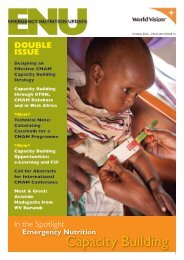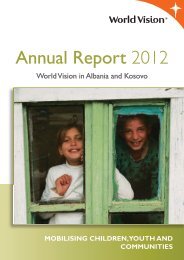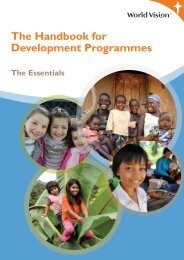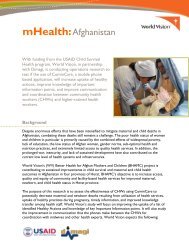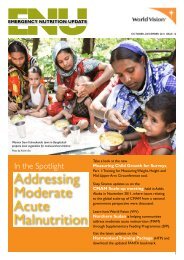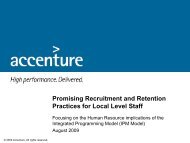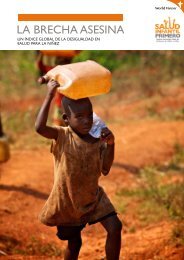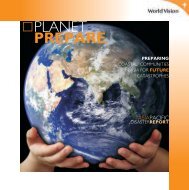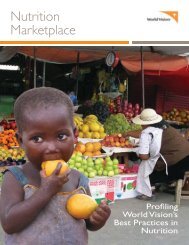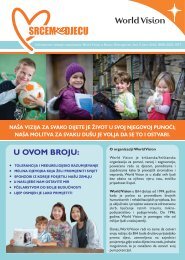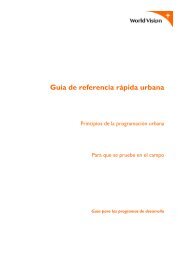Download Publication - World Vision International
Download Publication - World Vision International
Download Publication - World Vision International
- No tags were found...
You also want an ePaper? Increase the reach of your titles
YUMPU automatically turns print PDFs into web optimized ePapers that Google loves.
UgandaAnnual Report 2010Partnering for ImprovedChild Well-being
ContentsACRONYMS....................................................................................................................................................................... iiFROM THE BOARD CHAIRMAN............................................................................................................................... iiiiAnnual Report 2010FROM THE NATIONAL DIRECTOR.......................................................................................................................... ivINTRODUCTION............................................................................................................................................................ 1CHAPTER ONE: IMPROVING HEALTH AND COMBATING HIV/AIDS........................................................... 5CHAPTER TWO: IMPROVING QUALITY EDUCATION...................................................................................... 9CHAPTER THREE: WATER, SANITATION AND HYGIENE (WASH) IMPROVED.........................................11CHAPTER FOUR: ENSURING LIVELIHOOD SECURITY FOR FAMILIES AND HOMES............................13CHAPTER FIVE: GRANT-FUNDED PROGRAMMES CONTINUED TO GROW ..........................................15CHAPTER SIX: INNOVATIVE APPROACHES TO DEVELOPMENT AND CROSS-CUTTING ISSUES.....17ADVOCACY ON THE INCREASE.............................................................................................................................19WORLD VISION FINANCIAL STATEMENTS.........................................................................................................22
iiAnnual Report 2010AcronymsADP Area Development ProgrammeARP Area Recovery ProgrammeCBO Community-Based OrganisationCHN Child Health NowCVA Citizen Voice and ActionCSO Civil Society OrganisationEPRC Economic Policy Research CentreFAP Formerly Abducted PersonFBO Faith-Based OrganisationFENU Forum for Education NGOs in UgandaGIK Gifts in KindHEA Humanitarian Emergency AffairsINGO <strong>International</strong> Non Governmental OrganisationMDG Millennium Development GoalMED-Net Micro-Enterprise Development NetworkNUMAT Northern Uganda Malaria, AIDS and TuberculosisOVC Orphans and Vulnerable ChildrenPHAs People Living with HIV/AIDSPMTCT Prevention of Mother to Child TransmissionPTA Parents and Teachers’ AssociationSMC School Management CommitteeSNV Netherlands Development OrganisationUCWRP Uganda Children of War Rehabilitation ProgrammeVCT Voluntary Counseling and TestingVFI <strong>Vision</strong> Fund <strong>International</strong>WASH Water, Sanitation and HygieneWFP <strong>World</strong> Food ProgrammeWVU <strong>World</strong> <strong>Vision</strong> Uganda
I welcome you to this annual reporton the theme Partnering forImproved Child Well-being.One of <strong>World</strong> <strong>Vision</strong>’s aspirationsfor the well-being of children is tosee that they enjoy good health,but over time we have realized that<strong>World</strong> <strong>Vision</strong> cannot ensure this onits own. We need to work togetherwith other players, and this is thebasis of the theme for this year’sannual report.Today, around 24,000 children underthe age of five will die around theworld. Their deaths will be causedby malaria, pneumonia, diarrhea,AIDS and complications duringpregnancy and after birth.Two thirds of these deaths arepreventable. There are measuresthat can be taken to avert them,only that these measures arenot being deployed on the scalerequired to tackle the problem. Thisis why <strong>World</strong> <strong>Vision</strong> has launchedthe Child Health Now (CHN)campaign, a five-year initiativeaimed at preventing malaria andimproving nutrition among childrenand mothers. This campaign will goFrom the Board Chairmana long way in enabling WVU realizeits aspiration of enabling children toachieve good health.I reiterate that WVU will not beable to improve the health ofchildren in Uganda acting on itsown. Partnerships have becomeincreasingly important in this dayand age, and WVU has partneredwith the Government, otherCivil Society Organisations andthe communities not only for theCHN campaign but also in otherprogrammes. In this financial year,therefore, the organization embracedpartnerships in a more holistic way.Partnerships are importantbecause different entities havedifferent strengths. They can enableorganisations to downplay theirweaknesses and capitalise on thosethings that they do best. Partneringalso facilitates the continuity ofinitiatives in our programme areaswhen WVU transits out and makesmobilisation of people aroundpertinent issues easier. Furthermore,when you partner, you enter andengage in networks, which facilitatesinteraction between experts indifferent areas thus building theircapacity.It is therefore important that webuild the staff’s capacity to work withpartners and also WVU’s capacity toenter into collaborations and subgrantfunds to other players such asCommunity-Based Organisations. Weenvisage that increased investmentsin working with and through bothoperational partnerships at the fieldlevel and strategic partnerships atthe national level will result intoimprovements in children’s welfare.I thank all the partners that wehave worked with for trusting andcollaborating with us. I also thank allour Support Offices, sponsors anddonors without whose diligence andgenerosity WVU would not be ableto reach out to communities to themagnitude it does. In the next financialyear our partnerships will be strongerand more solid as we endeavour tocontribute to the development andwell-being of children, their familiesand communities.Richard Obura OnyangBoard Chairman.Partnerships have become increasingly important in thisday and age, and WVU has partnered with the Government,other Civil Society Organisations and the communitiesiiiAnnual Report 2010
ivAnnual Report 2010For the past 25 years, <strong>World</strong><strong>Vision</strong> Uganda has sought totransform the lives of childrenand the communities in whichthey live with a vision for everychild to ‘enjoy life in all its fullness’.This annual report highlightsthe progress and impact ofWVU’s work in 2010 under thetransformational development,advocacy and humanitarianemergency relief pillars.It draws attention to the importanceof reaching out to the poor andmost vulnerable communitiesthrough working in collaborationwith various partners underthe new ‘Integrated ProgrammingModel’ (IPM).<strong>World</strong> <strong>Vision</strong> embarked on IPM toenable local-level staff to workeffectively with partners towardsthe sustained well-being ofchildren within families andcommunities. The model wasestablished to reinforce the <strong>World</strong><strong>Vision</strong> Partnership’s decision torefocus on four child well-beingaspirations, which are that boysand girls: enjoy good health; areeducated for life; experience thelove of God and their neighboursand are cared for, protected andparticipating.Through IPM, WVU will:From the National Directora) Contribute to the sustainedwell-being of children withinfamilies and communities.b) Work effectively with localpartners because WVU’smost valuable input is toenable community groups,local organisations and otherpotential partners to workmore effectively towardsimproving and sustaining childwell-being.c) Equip local level staff with skillsin serving as catalysts, brokersand builders of the capacity oflocal partners contributing tochild well-being.d) Design parameters andguidance for basic elements ofprogramme designs includingtarget populations, geographicalsize, life span and cycle, disastermanagement, resourcingand governance as well assponsorship programmingwhere applicable.To complement local level partners,WVU has established a number ofrelationships at district and nationallevel. All clusters have signedmemoranda of understanding(MoUs) with districts. At the nationallevel, WVU has signed MoUs withThe Daily Monitor (Newspapers inEducation), Ministry of Health andthe Forum for Education NGOs inUganda (FENU).Under advocacy, WVU launchedthe Child Health Now campaign.This is <strong>World</strong> <strong>Vision</strong>’s first globalhealth campaign. In our HIV andAIDS programming, the two highestprogramming priorities are to carefor orphans, children living withHIV and other vulnerable childrenand their households and HIVprevention for girls, boys and youthfrom five to 24 years of age.To completement local levelpartners, WVU has establisheda number of relationships atdistrict and national level.The Northern UgandaComprehensive Water, Sanitationand Hygiene project was launchedin this financial year. Supported byRotary <strong>International</strong>, the project’sgoal is to reduce morbidity andmortality due to water, sanitationand hygiene-related diseases inKitgum, Pader, Amuru and Guludistricts.We continued supporting primaryeducation because we believethat education should lead to thedevelopment of a child’s well-being.This was done through support tobasic education and vocational skillstraining.I am thankful to the partnerswho have worked with WVU totransform the lives of children andtheir communities. I am also gratefulfor the commitment and tirelessefforts of the Board and staff ofWVU who work hard and investtheir lives in serving and changingthe lives of the poor.Enjoy reading this report!Rudo KwarambaNational Director.
Introduction<strong>World</strong> <strong>Vision</strong> Uganda (WVU) during 2010 continuedto make strides in its contribution to the developmentof Uganda, especially in contributing to communitytransformation and the well-being of children. This wasa continuation of the relief, community developmentand advocacy programmes the organization has beenimplementing since 1986 when the first relief andresettlement initiatives were started to help resettledistricts in central Uganda that had been devastatedby the 1981-87 war.<strong>World</strong> <strong>Vision</strong> Uganda in 2010 grew by leaps andboundsThe numbers below provide a glimpse of the majorWVU achievements during 2010: 29: the number of districts that WVUoperated in. 59: the number of Area DevelopmentProgrammes (ADPs) supported by theorganization. 101: the number of sub-counties whereWVU operated. 128,000: the number of registeredchildren who benefitted from WVUcommunity development programmes. 1,950,000: the number of peopleresiding in sub-counties where WVU hadprogrammes. 65,232,197: the total in US dollars(equivalent of Ug Shs. 141 billion) thatthe organization spent on programmes inUganda.Another major landmark during the year was thedesign and implementation of the new NorthernUganda Strategy for 2010-12 that focuses on thetransition from post-war relief to recovery anddevelopment.This strategy involves the establishment of AreaRecovery Programmes (ARPs) rather than AreaDevelopment Programmes (ADPs) in the districtsof Amuru, Gulu, Kitgum and Pader that cover thefollowing sectors: education, health and HIV/AIDS,water, sanitation and hygiene, vocational skillstraining, peace building and psychosocial support.Another major achievement was the implementationof the <strong>World</strong> <strong>Vision</strong> worldwide Child Health Now(CHN) campaign in Uganda, aimed at promotingMillennium Development Goal 4 regarding reducingdeaths of children below five years of age by twothirdsby the year 2015. Working with partners,WVU focused on reducing malaria and improving thefeeding of children and mothers with more balanceddiets.WVU received funding from a variety of sourcesWVU Area Development Programmes in Ugandareceived sponsorship and donor funding from 13countries: Australia Canada Finland Germany Hong Kong Japan Korea Netherlands1Annual Report 2010
Location of <strong>World</strong> <strong>Vision</strong> Uganda Area Development Programmes (ADPs)No. DISTRICT ADP No. DISTRICT ADP1. Amuria 1. Asamuk ADP 18. Masaka 30. Kaswa ADP2. Arua 2. Offaka ADP 31. Kyanamukaka ADP3. Bugiri 3. Nankoma ADP 19. Mbale 32. Namanyonyi ADP4. Buikwe 4. Ngogwe ADP 20. Mpigi 33. Kammengo ADP5. Buliisa 5. Buliisa ADP 34. Kituntu ADP6. Bundibugyo 6. Kasitu ADP 35. Nkozi ADP7. Busia 7. Busia TC ADP 21. Mukono 36. Kasawo ADP8. Busitema ADP 22. Nakaseke 37. Kasangombe ADP9. Lunyo ADP 23. Nakasongola 38. Kalongo ADP8. Butaleja 10. Budumba ADP 39. Nabiswera ADP11. Kachonga ADP 40. Wabinyonyi ADP9. Gulu 12. Gulu ADP 24. Nebbi 41. Panyimur ADP13. Koro-Bobi ADP 25. Ntoroko 42. Bundibugyo ADP14. Paicho-Bungatira ADP 43. Rwebisengo ADP10. Hoima 15. Buhimba ADP 26. Oyam 44. Aber ADP16. Kiziranfumbi ADP 45. Acaba ADP17. Kyabigambire ADP 46. Minakulu ADP11. Kabale 18. North Rukiga ADP 27. Rakai 47. Buyamba ADP19. Rukiga ADP 48. Kakuuto ADP12. Kalungu 20. North East Masaka ADP 49. Kooki ADP13. Kibaale 21. Kakindo ADP 50. Kyalulangira ADP22. Kasambya ADP 51. Lwamaggwa ADP23. Kiryanga ADP 28. Soroti 52. Arapai ADP24. Nalweyo-Kisiita ADP 53. Gweri ADP14. Kiboga 25. Katwe ADP 54. Kamuda ADP26. Kibiga-Mulagi ADP 55. Tubur ADP15. Kitgum 27. Kitgum ADP 29. Tororo 56. Iyolwa ADP16. Kole 28. Aboke ADP 57. Kirewa ADP17. Kyankwanzi 29. Ntwetwe ADP 58. Nabuyoga ADP59. Paya ADP3Annual Report 2010
Chapter One: Improving Health and Combating HIV/AIDSDuring 2010, WVU continued to address major public health concerns with a focus onchild health, malaria, poor feeding, HIV/AIDS and improved health for expecting mothers.The following are some of the highlights during 2010.The organization improved the health of targetedpeople through improved feeding: 13: the number of districts where <strong>World</strong> <strong>Vision</strong>trained health workers and supported them toprovide feeding for malnourished children andbabies. 13: the number of districts where <strong>World</strong> <strong>Vision</strong>promoted the growing of and feeding on a varietyof nutritious foods grown in kitchen and backyardgardens. 20: the number of districts where <strong>World</strong> <strong>Vision</strong>promoted health and nutrition information,communication and education at communitylevel using Village Health Teams.Underweight child recoversOn the first day of the Positive Deviance Hearth activity inKatwe ADP, Naiga (not real name) was one of the elevenchildren enrolled on the program. She was one and ahalf years old but weighed only 6.5 kgs and presentedwith grade 1 edema. Naiga’s mother Mbabazi (not realname) was already visibly pregnant and yet she had neverattended any antenatal clinics nor prepared a birthingplan. Naiga had been delivered from home with the help ofa relative and by 18 months had not yet been vaccinatedfor measles. On enrollment to the hearth, Mbabazi, like10 other women, started participating in the cooking andhealth education lessons as well as feeding her child. Bythe end of the 12 days of the hearth, Naiga had been fullyvaccinated, de-wormed and gained half a kilogram (500g)of body weight.The organization also assisted a number ofcommunities to access quality health servicesthrough: 7: number of health centres built. 10: the number of water tanks built. 15: the number of staff houses built. 134: the number of health seminarsconducted. 348: the number of immunization aidestrained. 6,459 : the number of registered childrentreated. 28,818: the number of insecticide-treatedmosquito nets distributed to pregnant mothersand children under the age of five. 70,384:the number of children immunized.5Annual Report 2010
6Annual Report 2010<strong>World</strong> <strong>Vision</strong> Uganda continued to fight HIV/AIDS and improve the lives of peopleliving with HIV/AIDS through: 72: the number of associations ofpeople living with HIV/AIDS (PHAs)that WVU worked with 77: the number of HIV/AIDS dramagroups that WVU trained and workedwith. 100: the number of PHAs whoreceived food supplements fromWVU. 139: the number of associationsthat worked as HIV/AIDS partnerswith WVU. 229: the number of HIV/AIDScounselors trained by WVU. 3, 782: the number of PHAswho registered and received regularassistance from WVU 4,359: the number of PHAs thatwere linked to ARV providers. 4,465: the number of outof-schoolchildren reached withprevention/life skills messages. 4, 477: the number of motherssupported under the Preventionof Mother to Child Transmission(PMTCT) of HIV/AIDS campaign. 42,185: number of peoplesupported with voluntary counselingand testing services. 43,842: the number of schoolchildren reached with HIV/AIDSmessages.Specifically in Northern Uganda, through theNorthern Uganda Malaria, AIDS andTuberculosis (NUMAT) Programme, WVUcontinued to assist communities to receive qualityHIV/AIDS, Tuberculosis and malaria prevention, careand treatment services as illustrated by the numbersbelow: 10,000: number of clients whoreceived anti-retroviral treatment. 79,000: number of pregnantmothers who received prevention ofmother to child transmission of HIV/AIDS services. 200,000: the number of peoplewho received HIV/AIDS testingservices. 250,000: the number of peoplewho received HIV/AIDS messages.The above-mentioned targets were achieved byworking with and through the following partners: National Tuberculosis and Leprosy ControlProgramme National AIDS Control Programme <strong>World</strong> Health Organization <strong>International</strong> Union Against TB and Lung Disease Local Governments
Supporting Public Sector workplaces to expandaction and responses towards HIV/AIDS(SPEAR)During 2010, WVU, with funding from PEPFAR,continued to support selected public sectors in theMinistry of Education and Sports, Local Governmentand Internal Affairs to improve HIV/AIDS prevention,care and treatment as shown in the figures below: 35: the number of groups of PHAs in thedifferent Ministries, Departments and atdistrict level 98: the number of workplace HIV/AIDSchampions, including PHAs, who were trainedand deployed to support policy disseminationat their workplaces. 512: the number of individuals who wereidentified to be HIV-positive and assisted toreceive palliative care that included treatmentof opportunistic infections, anti-retroviraltreatment and psychosocial counseling. 4,017: the number of public sectorworkers, including PHAs, who were trained inHIV/AIDS prevention. 19,164: the number of public sectorworkers and their families who were assistedwith counseling and testing and received theirresults. 45,192: the number of public sectorworkers and their families who were reachedwith sexual and other behavioral riskprevention messages.7Annual Report 2010Stakeholders sign the Child HealthNow petition at the campaignlaunch/Davinah Nabirye
148Annual Annual Report 2010Education:A teacher assists a pupilin a school supported by<strong>World</strong> <strong>Vision</strong> in Paicho-Bungatira ADP,Gulu district/Simon Peter Esaku
10 16Annual Report 2010Water:A child fetches waterfrom a borehole drilledby <strong>World</strong> <strong>Vision</strong> in Abimdistrict/Simon Peter Esaku
12Annual Report 2010Livelihood Security:Community members open up landfor cultivation using an ox plough given by<strong>World</strong> <strong>Vision</strong> in Amuru district/Sylvia Nabanoba
Chapter Four: Ensuring Livelihood Security forFamilies and HomesDuring 2010, WVU worked with communities in programme areas to increase incomes,food security and nutritious food (for home consumption and sale) as well as employmentopportunities. Overall the following were achieved: 17: the number of agricultural study toursorganized for farmers. 104: the number of ox-ploughs distributedto farmers who were able to cultivate moreland beyond what they used to using handheldhoes. 152: the number of oxen given out forploughing. 406: the number of heifers given out toincrease milk for children and extra for selling. 1,074: the number of goats given out. 1,835: the number of contact farmerstrained in improved farming and increasingthe number and types of crops grown. 14,427: the number of kilogrammes ofimproved maize seeds distributed. 27,243: the number of kilogrammes ofimproved bean seeds distributed. 66,000: the number of clonal coffeeseedlings distributed. 116,920: the number of tree seedlingsgiven out and planted.An example of partnerning with the localcommunity to improve agricultural productionwas from Nkozi ADP where WVU worked withthe sub-county agricultural extension servicesstaff to train farmers on the farm itself. Fourmodel farmers were selected and given 40,000pineapple suckers and established gardens thatserved as learning centres for their villages.Increasing Incomes with MED-Net ThrivesWVU supported individuals, families and groups tofight poverty and increase their incomes throughMED-Net (Micro Enterprise DevelopmentNetwork), a micro-finance institution affiliated toWVU. During 2010, MED-Net continued to workin 24 <strong>World</strong> <strong>Vision</strong>-supported Area DevelopmentProgrammes providing agricultural, business andeducation loans.MED-Net continues to grow as shown 29%: Staff numbers increased from 78 in2009 to 101 in 2010 81%: Children benefitting from Med-Netfrom 24,885 in 2009 to 45,042 in 2010 85% : Portfolio grew from Ug. Shs 3.1billion in 2009 to Ug. Shs. 5.7 billion in 2010 180%: Number of clients increased from5,916 in 2009 to 10,600 in 201013Annual Report 2010
14Annual Report 2010Grants:A <strong>World</strong> <strong>Vision</strong> staff memberhelps a woman carry food distributedby WVU and WFP in Karamoja/Davinah Nabirye
16Annual Report 2010Partnerships:Children read the Newspapersin Education supplement, published byThe Monitor <strong>Publication</strong>s/Simon Peter Esaku
Chapter Six: Innovative Approaches to Developmentand Cross-cutting IssuesInnovative partnershipsDuring 2010, WVU continued to put emphasis on increasing partnerships and externalengagement as a way of implementing programmes at the field level and strategicpartnerships at the national level.17Annual Report 2010Some of the notable partnerships in place during 2010include: Newspapers in Education (NiE) with TheMonitor <strong>Publication</strong>s Ltd. that providesnewspapers for primary school children in 10districts. A Memorandum of Understanding withMakerere University Department of PublicHealth that resulted into the incorporation ofthe Interpersonal Psychotherapy for Groups(IPT-G), a depression intervention model usedby <strong>World</strong> <strong>Vision</strong> in Masaka and Rakai, into thecurriculum of the Bachelor of CommunityPsychology programme at the university. In partnership with the Economic PolicyResearch Centre at Makerere University, thequality of primary education in Kiboga, Hoima,and Apac districts is being monitored andthe findings being shared with the DistrictEducation Officers for future planning. WVU sub-granted over Ug. Shs 634 million(equivalent of US$ 244,000) to 80 localpartners to implement activities focusingon the well-being of children and theircommunities.Giving Citizens a VoiceWVU continued to strengthen citizens’ voices toinfluence the quality of services delivered to them bythe Government through the Citizen Voice and Actioncampaign. This has made the local government to bemore responsive and accountable.A good example is in Nakasongola District where ahealth worker at Kawaka Health Centre II had notbeen paid her salary for six months. However, this wassorted out when the issue came to the attention ofthe local Citizen Voice and Action team that wroteto the District Medical Officer and copied the ChiefAdministrative Officer, who is the accounting officerfor the district. From then, the community learnt tolisten to the challenges that face service providersand seek solutions to them so that together they canserve one another better.Gifts in Kind compliment development effortsDuring 2010, WVU received Gifts-in-Kind that wereintegrated into the ADP plans and interventions foreducation, health, HIV/AIDS and emergency relief.WVU received 31 consignments of products thatranged from medical examination tables, medicaldrugs, textbooks and caretaker kits for those takingcare of HIV/AIDS patients.
18Annual Report 2010Child Protection:Child protection initiatives resultin happy, confident children/Davinah Nabirye
Advocacy on the IncreaseDuring 2010, the organization increased its advocacy interventions. The main areas ofadvocacy for WVU were in child rights, gender, birth registration, fighting gender-basedviolence, peace-building and conflict management, disability and environmental protection.19Annual Report 2010The magnitude of the intervention can beseen below: 23: number of advocacy activities engaged indisability 27: number of conflict resolution activitiesengaged in, including training in Local Capacitiesfor Peace (LCP) framework. 28: number of environment protection activitiesengaged in 43: number of gender issues engaged in,including increasing the capacity of communitiesto address gender-based violence 64: number of coalitions/networks where ADPsparticipateChristian Commitments supports dialogueand unityDuring the year under review, WVU supported 80Church leadership training sessions and trained540 Sunday School teachers which led to child-wellbeing issues being taken seriously among a numberof religious institutions in communities where WVUoperates.In Ngogwe ADP different religious leaders werebrought together and they have formed NgogweReligious Leaders Association (NGORLEA) , whichamong other things is advocating for children’s rightsand fights harmful practices, child abuse and poverty.ChristianCommitment:Programmespromote thespiritual nurtureof childrenDavinah Nabirye 254: number of child rights advocacyactivities engaged in. These included pursuing theprosecution of abuse cases, early child marriage,birth registration, and child participation in issuesthat concern them.
20Annual Report 2010Concerned about the environmentIn partnership with Oxfam GB Uganda, Save theChildren in Uganda, Care <strong>International</strong> in Uganda,<strong>World</strong> <strong>Vision</strong> continued to implement the AfricaClimate Change Resilience Alliance Project (ACCRA),a nation-wide advocacy initiative dealing with issuesof climate change.Child protection promoted to a higher levelDuring the year under review, WVU continued tobuild partnerships and networks that promotedchild protection. Working with the Uganda ChildRights NGO Network (UCRNN), Save the Childrenin Uganda, Plan <strong>International</strong>, UNICEF and UNFPA,proposals to amend the Birth and Death Act anddevelop a policy on child registration were pushedand later on approved by the Cabinet.Working with Save the Children in Uganda and theUganda Law Reform Commission, WVU advocatedfor amending the Children’s Act to and abolishcorporal punishment and strengthen child adoption.<strong>World</strong> <strong>Vision</strong> used the Day of the African Child, 16June to partner with the Ministry of Gender, Labourand Social Development to profile children issues.During 2010 children were mobilized to write amemorandum highlighting solutions to problemsthey face and this was handed over to the Ministerof Youth and Children’s Affairs.Busia: A case of successful interventions for childprotectionChild protection systems in Busia Town Council<strong>World</strong> <strong>Vision</strong> Uganda worked with partners to strengthenthe child protection systems in Busia Town Council. Childfocusedorganizations formed the District Orphansand Vulnerable Children Coalition Committee, whichdeveloped a system for referring cases of child abuse,resulting in an increase in the number of cases reported.Child friendly shelter in Busia borderWVU and the Uganda Police established a child-friendlyshelter and counseling centre at Busia Police Stationin Busia town on the Uganda-Kenya border whereabandoned children or children in need of protectionsleep. Before, such children would either sleep at thePolice counter or in the Police cells. Children are at riskin Busia, known for its cross-border trade, child traffickingand child prostitution. The police officers have also beentrained in child-friendly handling of child abuse cases.Piloting an alternative to police backgroundcheck<strong>World</strong> <strong>Vision</strong> piloted a child protection project in BusiaADPs to implement an alternative to police backgroundchecks. In March 2010, a child protection monthlytracking template was distributed and tested in theBusia projects in Busia Town Council, Busitema, Lunyo andNankoma in Bugiri district. A child abuse incident reportformat was developed and shared with staff. Incidents ofchild abuse can be reported to UGA_Child_Protection@<strong>World</strong><strong>Vision</strong>.Bye-laws barring bars and video halls fromadmitting children – Busia Town Council enactedthese bye-laws. Policing of the law is effectively done byChild Protection Committees together with the Police.Child Protection Handbook – The District ProbationOffice, with support from <strong>World</strong> <strong>Vision</strong>, came up witha child protection handbook for child abuse caseintervention.
21Annual Report 2010Child Participation:Children present their memorandumat <strong>World</strong> AIDS Day 2009 celebrations/Sylvia Nabanoba
22Annual Report 2010<strong>World</strong> <strong>Vision</strong> Financial StatementsWORLD VISION UGANDA NATIONAL OFFICEINCOME STATEMENTFOR THE YEARS ENDED 30TH SEPTEMBER 2010/2009Actual Actual Actual Actual2010 2010 2009 2009USD SHS USD SHSINCOMEFUNDING FROM WORLD VISIONINTERNATIONAL36,845,365 79,931,812,855 36,122,202 60,899,431,773OTHER INCOME 271,652 589,318,000 2,059,743 3,472,578,397GIFTS IN KIND ( GIK) EXPENDITURES 29,696,995 64,424,240,246 29,163,096 49,166,880,113TOTAL INCOME 66,814,012 144,945,371,101 67,345,041 113,538,890,283EXPENDITURES:PROJECT EXPENDITURES 34,823,330 75,545,238,771 36,800,631 62,043,214,221GIK EXPENDITURES 29,696,995 64,424,240,246 29,163,096 49,166,880,113TOTAL PROJECT EXPENDITURES 64,520,325 139,969,479,017 65,963,727 111,210,094,334
23STRATEGIC MANAGEMENTCOSTSSALARIES 3,542,595 7,685,255,406 3,385,351 5,707,458,041EMPLOYEE BENEFITS 1,554,143 3,371,535,807 1,420,123 2,394,225,129TRAINING 417,437 905,581,914 355,303 599,015,276SUPPLIES 508,919 1,104,041,669 469,313 791,227,927TRAVEL 1,257,945 2,728,968,062 1,231,271 2,075,834,254INTEROFFICE EXPENSES 84 182,228 61 102,842OCCUPANCY 261,381 567,036,239 285,885 481,981,526TELEPHONE/TELEX/POSTAGE 532,151 1,154,440,841 277,470 467,794,442HOSPITALITY 31,957 69,327,063 41,982 70,778,629PRINTING 78,096 169,420,356 48,971 82,561,580ADVERTISING 40,438 87,725,624 54,593 92,039,867FEES AND TAXES 97,725 212,003,231 139,015 234,369,281CAPITAL EXPENDITURE 39,656 86,029,165 10,325 17,407,207SUB OFFICE FUNDING 177,857 385,840,456 -100,212 -168,950,217DIRECT OPERATING SUPPORTCOSTSTOTAL STRATEGICMANAGEMENT COSTS-7,828,512 -16,983,063,029 -6,305,108 -10,629,958,120711,872 1,544,325,032 1,314,343 2,215,887,665Annual Report 2010TOTAL EXPENDITURE 65,232,197 141,513,804,049 67,278,070 113,425,981,999NET INCOME(EXPENDITURE)EXCHANGE DIFFERENTIAL (LOSS)GAINNET INCOME (DEFICIT) FORTHE YEAR INCLUDING EXCHANGE DIFFERENTIAL1,581,815 3,431,567,052 66,971 112,908,284-1,581,815 -3,431,567,052 -66,971 -112,908,2840 0 0 0
24Advisory Board MembersAnnual Report 2010Mr. Richard Obura-OnyangBoard ChairmanMrs. Ruth SenyonyiVice ChairpersonDr. Charles OwubahVice-President East Africa RegionDr. Ekiria KikuleMemberMr. Fred MukhwanaMemberMrs. Mary Ssonko NabachwaMemberDr. Fred MuhumuzaMemberMr. Anthony EsenuMemberProf. Wilson MandeMemberMrs. Rita Balaka MitalaMemberMs. Rudo KwarambaNational Director & Board Secretary
Senior Leadership TeamMs. Rudo KwarambaNational DirectorMr. Geoffrey IsingomaMinistry Quality DirectorMr. Lawrence TiyoyProgrammes DirectorMrs. Amelia MuwanguziSupport Services DirectorMrs. Margaret KagimbaPeople & Culture DirectorMr. Hugh GreatheadHEA DirectorMr. Jwanesh PasupuletiFinance Director
<strong>World</strong> <strong>Vision</strong> UgandaPlot 15B Nakasero Road, P.O. Box 5319 Kampala (U).Tel: +256-414-345758, +256-414-340395, +256-414251642, Fax: +256-414-258587Email: uganda@wvi.org. website:www.wvi.orgUganda


